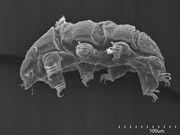Tardigrade
|
|
| Water Bears | ||||
|---|---|---|---|---|
 | ||||
| Scientific classification | ||||
| ||||
| Classes | ||||
Tardigrades (Tardigrada), or "water bears", are a phylum of small, segmented animals, similar and related to the Arthropods. Tardigrades were first described by J.A.E. Goeze in 1773 ('kleiner Wasserbär'=little waterbear). The name Tardigrada means "slow walker" and had been given by Spallanzani in 1776. Tardigrades are small animals. The biggest adults may reach a body length of 1.5 mm, the smallest below 0.1 mm. Fresh hatched larvae may be smaller than 0.05 mm.
Most tardigrades are phytophage or bacteriophage, but some are predators (e.g. Milnesium tardigradum).
| Contents |
Classification
Fossil records are sparse. The species Beorn leggi has been recorded from Canadian Cretaceous amber. Aysheaia from the middle Cambrian Burgess shale might be related to tardigrades.
Recent DNA and RNA sequencing data indicate that Tardigrades are the closest sister group to the Arthropods, even closer than Onychophora. These groups have been traditionally thought of as close relatives of the Annelids, but newer schemes consider them Ecdysozoa, together with the roundworms and several smaller phyla. The ecdysozoa-concept resolves the problem of the nematode-like pharynx as well as some data from 18S-rRNA and HOX (homeobox) gene data, which indicate a relation to roundworms.
Location and Environment
There are about 750 species described. Tardigrades occur over the whole world, from the high Himalaya (above 6000 m) to the deep sea (below 4000 m) and from the polar regions to the equator.
The most convenient place to find tardigrades is roof mosses, where they live in the water films around lichens and mosses. Other environments are dunes, beaches, soil and marine or freshwater sediments, where they may occur quite frequent (up to 25,000 animals/L).
Scientists have reported their existence in hot springs, on top of the Himalayas, under layers of solid ice and in ocean sediments. Many species can be found in a milder environment like lakes, ponds and meadows, while others can be found in stone walls and roofs.
Tardigrades have been found in so many different and varied environments that it is believed that they can be found virtually anywhere. All species need to be in liquid water for active life. Some species are marine, others live in freshwater environments.
Tardigrades and Extreme Environments
Tardigrades are one of the few species that are capable of reversibly suspending their metabolism and going into a state of cryptobiosis. One Tardigrade was recorded to be in this state for over 120 years. Depending on the environment they may enter this state via anhydrobiosis, cryobiosis, osmobiosis or anoxybiosis. While in this state their metabolism lowers to less than 0.01% of what is normal and their water content can drop to 1% of normal. They have been known to withstand the following extremes whilst in this state:
- Temperature—Tardigrades can survive being heated in boiling water for a few minutes at 151 °C and survive being chilled for days in temperatures at -272.8 °C (absolute zero).
- Radiation— Shown by Raul M. May from the University of Paris, Tardigrades can withstand 5700 Grays of x-rays (5 Grays would be fatal to a human).
- Pressure—They can withstand being in a vacuum and in pressures that are many times greater than atmospheric pressure. They can even survive the vacuum of space.
Tardigrade characteristics
- Body with four segments and head
- Ventral nervous system with one ganglion per segment
- Multilobed brain
- Triradiate muscular sucking pharynx
- Stylets
- Cuticle with chitin, molting
- Males and females present (though some species are parthenogenetic)
- Four pair of legs (in genus Hexapodibius reduced to three) without joints
- Feet with claws or toes
- Oviparous
See also
References
- http://www.itis.usda.gov (TSN: 155166)
External links
- The Edinburgh Tardigrade project (http://www.tardigrades.org/)
- Tardigrade Appreciation Headquarters (http://www.q7.com/~vvv/tardigrade/)
- Tardigrades (English/German) (http://www.tardigrades.de)
- The incredible water bear! (http://www.microscopy-uk.org.uk/mag/artjun00/mmbearp.html)da:Bjørnedyr
de:Bärtierchen es:Tardígrado fr:Tardigrades la:Tardigrada nl:Tardigrada nds:Tardigrada ja:緩歩動物 fi:Karhukainen ru:Тихоходки sv:Tardigrada
